![]()
![]()
![]()
Use LEFT and RIGHT arrow keys to navigate between flashcards;
Use UP and DOWN arrow keys to flip the card;
H to show hint;
A reads text to speech;
46 Cards in this Set
- Front
- Back
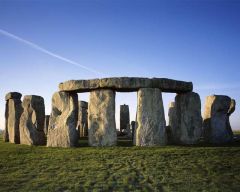
|
1. Stonehenge/ England 3. bluestone / henge 4. prehistoric 5. tremendous dedication of manpower to drag 50 ton stone megaliths 24 miles, smaller stones dragged from Wales. It was likely created as a place of ritual gathering. |
|
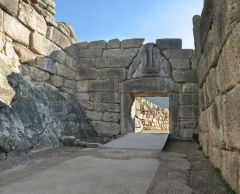
|
1. Lion's gate/ Mycenae 3. stone/ post and lintel 4. archaic Greek 5. part of the city described by Homer as "the city of gold," Mycenae was culturally and economically influenced by Egypt, an example of early Greek culture, coined(or created???) the term for fortified city (walled), corbelled arch |
|
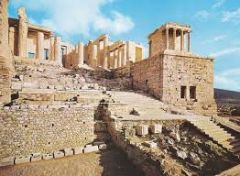
|
1. propylaea/ Western end of acropolis 2. Mnesikles 3. marble, transitioned from stone 4. classical greek 5. It's the gateway to the acropolis, determines how one moves around and into the acropolis, Doric Facade with more Ionic interior (reflects parthenon), there were two wings: pinakotheke (picture gallery )and potentially library |
|
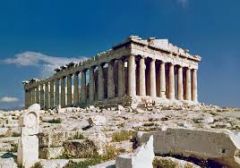
|
1. parthenon/ acropolis, athens, greece 2. Iktinos and Kallikrates 3. marble 4. classical greek 5. -Not the local material of Athens, signifies importance. -curvature, most likely for aesthetic value to add liveliness...intercolumnation is irregular -mixture of doric and ionic orders -temple to Athena -perfect proportion (the golden section) |
|
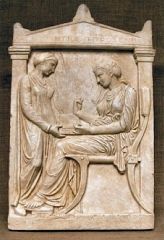
|
1. grave stele of Hegesos/ Athens, Greece 2. Phiedan style 3. marble/ relief 4. classical greek 5. stele is a boundary marker between life and death, Hegeso is looking through a jewelry box, drapery and smooth planes, idealized faces, quiet mood of the scene |
|
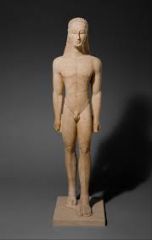
|
1. New York Kouros 3. limestone/ sculpture in the round 4. archaic greek 5. -celebrated athletes, temple markers, graver markers -it gives a baseline for the achievements made in greek sculpture, thorax inscribed instead of sculpted, less naturalistic |
|
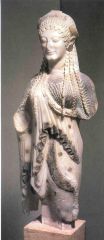
|
1. kore/ chios 2. unknown 3. marble/ statue in the round 4. archaic greek 5. female figure, known for how well the color has preserved |
|
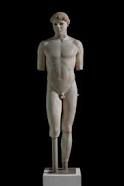
|
1. Kritios boy/ rubble of the Acropolis 2. Kritios 3. marble/ statue in the round 4. 480 BC 5. -revolution in contrapposto -individual, not a generic figure |
|
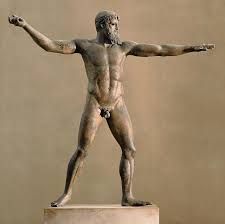
|
1. Zeus/Poseidon 2. unknown 3. Bronze/ statue in the round 4. classical Greek 5. problem of showing movement solved muscles show imminent movement, lifting of feet |
|
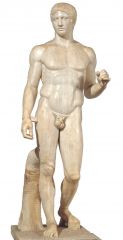
|
1. Doryphorus/ Pompeii 2. Polykleitos 3. marble copy of bronze statue in the round 4. classical greek 5.-the 'canon' the perfect male nude (standard of excellence) -everything is in proportion -precise moment of youth to manhood |
|
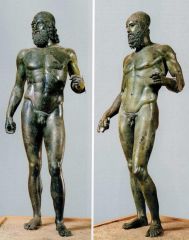
|
1. Riace bronzes/ found in a shipwreck off of Riace 2. unknown 3. bronze/ statue in the round 4. Classical Greek 5. show naturalistic, contrapposto, assymetry, realistic hair, silver teeth |
|
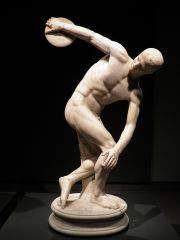
|
1. Discobolus 2. Myron 3. bronze / statue in the round 4. Classical Greek 5. false but convincing way to throw a discus |
|
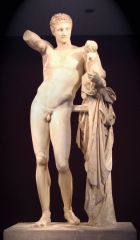
|
1. Hermes holding out the grapes from baby Dionysus/ Olympia 2. Praxitiles 3. marble/ statue in the round 4. Hellenistic Greek 5. creates a narrative, genre moment between Gods |
|
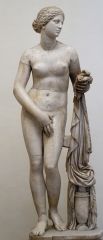
|
1. Aphrodite of Knidos 2. Praxitiles 3. marble/ statue in the round 4. Hellenistic Greek 5. first female nude, inhabitants of Knidos purchased the alternate, nude statue and profited from her fame, blatant eroticism |
|
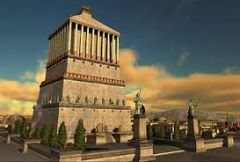
|
1. Mausoleum of Halikarnassus/ southern coast of modern day Turkey 2. Pytheos of Priene 4. Classical Greek 5. biggest tomb ever built, created term mausoleum means very large tomb, built for Mausolus, ruler of Caria, one of seven wonders, sanctioned by Mausolus' wife |
|
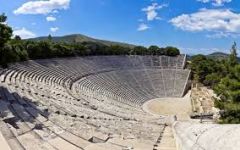
|
1. Epidauros/ Peloponnese, Greece 2. unknown 4. Hellenistic Greek 5. -scoop shape created wonderful acoustics -built to move with the landscape, wedgelike sections of seats facilitated audience circualation |
|
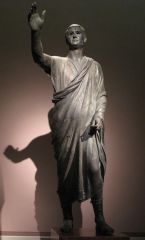
|
1. Arringatore/ Lake Trasimeno, Italy 2. Etruscan artist 3. bronze/ statue in the round 4. Republican Rome 5. -Romans focused on portraiture while Greeks focused on idealized beauty -representation of a Roman official -shows Etruscan skill in metal work -Arringatore means orator |
|
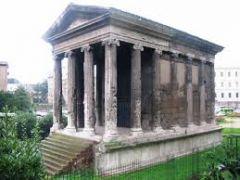
|
1. Temple of Portunus/ ??? 2. ??? 3. ??? 4. Imperial Rome 5. higher podium than Greek temple, freestanding columns only on pronaos (which is deeper), much less sculpture and decoration despite being ionic |
|
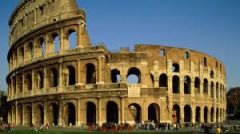
|
1. Colosseum/ Rome 2. built under Vespasian 3. concrete, travertine/ amphitheatre 4. Imperial Rome 5. vomitorium and golas for smooth traffic flow created for gladiator fights, one of the largest buildings anywhere, barrel vaults made ring remarkably stable, Romans took seats according to social rank, doric, ionic, and corinthian columns |
|
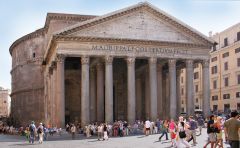
|
1. Pantheon/ Rome 2. Marcus Agrippa, possibly rebuilt after fire by Apollodorus 3. concrete, granite, bronze 4. Imperial Rome 5. coffers in ceiling relieve weight, oculus allows light and astronomical clock, encloses a perfect sphere, sense of perfect geometry, "the temple to all of the gods", extraordinary result of increased confidence in potential and strength of concrete, 142' uninterrupted diameter |
|
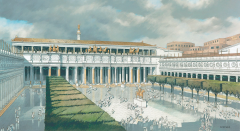
|
1. Trajan's Forum/ Imperial Fora, Rome 3. Basilica, libraries, temple, courtyard 4. Imperial Rome 5. Greek and Latin libraries, emperors are deified, architecturally controlled experience, captive Dacians instead of caryatids, shows wealth of Rome after Dacian wars, basilica used for business of people, financed by the spoils fo the war the Dacia |
|
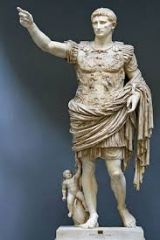
|
1. Augustus Prima Porta 2. unknown 3. marble/ statue in the round 4. Imperial Roman 5. "a portrait" of Augustus, orator pose, reminiscent of Arringatore, military leader and ordinary citizen (bare feet, toga, powerful orator, elaborate breastpiece), cupid symbolizes Augustus' claim of descent from the goddess of love, depicted as youthful and athletic despite his middle age, Breastplate signifies military victory, bringer of Pax Romana with gods on his side |
|
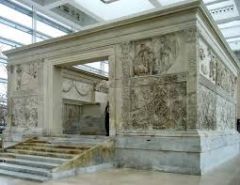
|
1. Ara Pacis Augustae/ Northern outskirts of Rome 2. unknown 4. Imperial Rome 5. thanksgiving to the gods for roman peace during the Pax Romana under Augustus, richly decorated panels express message of peace |
|

|
1. Arch of Titus/ beginning of Sacred Way, Imperial Fora, Rome 2. Giuseppe Valadier, built under emperor Domition 3. marble/ triumphal arch 4. imperial Rome 5. celebrating quell of Palestine Rebellion, particularized celebration of a particular event, frieze depicts procession of soldiers through the arch, emperor on opposite wall, earliest surviving freestanding arch in Rome, different levels of relief |
|
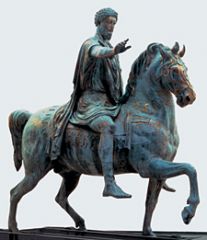
|
1. Equestrian state of Marcus Aurelius/??? 2. unknown 3. gilded bronze/ statue in the round 4. Imperial Rome 5. equestrian statues only for emperors, misidentified as Constantine so it wasn't melted in medieval period, proportion adjustment, simple toga=regular citizen, philosopher emperor w beard =wisdom instead of youth, interested in philosophy, more abstract quality of Roman portraits |
|
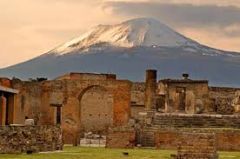
|
1. Pompeii/ near Vesuvius 2. n/a 3. n/a 4. Imperial Rome 5. city buried under ash preserved casts, buildings, food -shows how houses turn inward, highly decorated vestibule houses for rich romans |
|
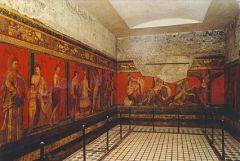
|
1. Villa of the Mysteries/ outside the gates of Pompeii 2. unknown 3. villa with mural 4. Republican Rome 5. no sleeping cubicles or kitchen, likely a religious ceremonial cult center, shows simultaneity of religions in roman empire, figures engaging each other across space, typical red paint of rome |
|
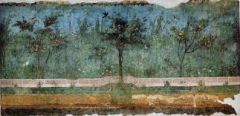
|
1. Villa Livia/ Primaporta 2. unknown 3. fresco 4. Imperial Rome 5. garden in the round, elaborate painting unusual to rome so that all species are identifiable, Livia was Augustus' consort, inclusion of foreground and background |
|

|
1. St. Denis/ France 2. rebuilt by Abbot Suger 3. stone/ribbed vaulting 4. Gothic 5. ribbed vaulting allowed for gigantic scale, skeletal stone structure allowed by foundations, buttressing counteracts thrust, engineering turned aesthetic, first building to use stone lines, double ambulatory as a continuous space, lightness distinguishes it from earlier churches |
|
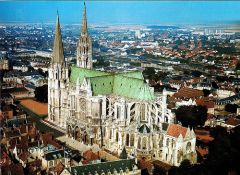
|
1. Cathedral of Notre-Dame/ Chartres, France 2. bishop of Chartres 3. stone cathedralq 4. Gothic 5. built grander and more spectacular after burning down, represents emergence of a nation, scholasticism=devotion to scholarly endeavors as church was center of all town activity, dedicated to the virgin Mary, important iconography: understanding of images, naturalistic trend in Gothic scupture as opposed to stylization |
|

|
1. Elgin marbles/ east pediment of the Parthenon, Acropolis 2. Phideas 3. marble sculpture relief 4. classical Greek 5. Panathenaic procession honoring Athena, Its iconography integrated Athenians and gods together |
|
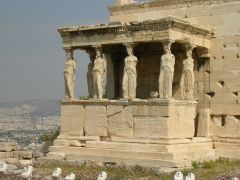
|
1. The Erechtheion/ next to Parthenon in Acropolis 2. Mneskiles 3. marble 4. classical Greek 5. caryatids (draped females figures used to support the entablature), women bear the burden of their conquered state, built on difficult terrain, olive tree and pool from Athena and Poseidon, 2 porches for poseidon and maidens |
|
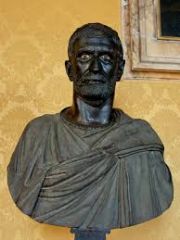
|
1. Brutus 2. unkwown 3. bronze bust/sculpture in the round 4. Republican Rome 5. more naturalistic and individualized, less idealized, Brutus was the founder and first consul of the Republic, power comes from creases and furrows |
|

|
1. Head of a Roman Patrician/Veristic Male Portrait 2.unknown 3. stone/ bust 4. Republican Rome 5. Veristic: the quality of appearing realistic, Men probably commissioned these portraits as aspiring politicians, veil suggests priest, shows roman ideal in seniority (responsibility and experience), placed in home to provide visual geneology |
|
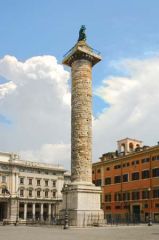
|
1. Trajan's column/ Trajan's Forum, the Imperial Fora 2. Apollodorus of Damascus 3. freestanding marble column with relief carving 4. Imperial Rome 5.celebrates last conquest of Roman Empire in Dacia as a visual unwound scroll-NARRATIVE as a Roman contribution, chronicling of events, allocutio: addressing of the troops by the emperor |
|

|
1. Basilica of Maxentius/ Roman Forum 2. commissioned by Maxentius 3. concrete 4. Imperial Rome 5. largest roofed interior in Rome, large clerestory created light and airy quality, Constantine expropriated basilica with name and colossal portrait, showing importance of physical presence in the city |
|

|
1. Reliquary of Sainte Foy/ Conques, France 3. gold with precious stones, statue in the round 4. Middle Ages 5. a young martyr who could heal people, a relic: object deemed holy by the church, offered remission from Catholic sins, put Conques on the map as a pilgrimage pitstop (traveling away from home to a holy destination) |
|

|
1. Kroisos Kouros/ Anavysos 2. unknown 3. marble statue in the round 4. archaic greek 5. new use of curves, knowledge of how body works, process of naturalism, used in sanctuaries and cemeteries, funurary statue of Kroisos who died in battle |
|
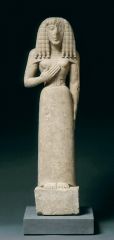
|
1. Kore (maiden) 2. unknown 3. limestone sculpture in the round 4. archaic greek 5. rigidly frontal, egyptian influence, four distince sides, stylized wiglike hair |
|

|
1. temple of Athena Nike/ acropolis 2. Kallikrates 3. marble 4. classical greek 5. early fully Ionic temple on the Acropolis, first building you see in the Acropolis, housed the statue of Nike and her sandal |
|
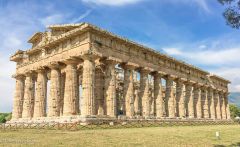
|
1. Temple of Hera/ Olympia, Greece 2. 3. mudbrick, limestone, bricks, wood 4. archaic Greek 5. stored items important to greek culture, one of the earliest Doric Greek temples, peripteral temple (columns going all the way around) |
|
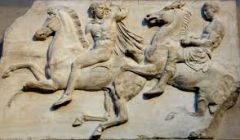
|
1. Panathenaic procession/ frieze of Parthenon 2. Phideas 3. marble relief 4. classical Greek 5. part of the inner, continuous Ionic frieze, part of a festival held to honor Athena and the Gods, idealized event rather than specific moment, regular Greeks in a place usually reserved for Gods |
|

|
1. Charioteer from Motya, Sicily 2. unknown 3. marble sculpture in the round 4. classical greek 5. very rare surviving example of an original greek victor's statue, represent the winner of a chariot race, "wet looking drapery" |
|
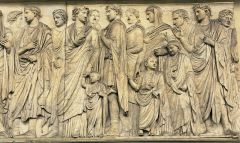
|
1. Imperial Procession Frieze/ Ara Pacis Augustae 2. unknown 3. marble relief 4. Imperial Rome 5. shows Greek preference of Augustan age, members of imperial family, a particular event on the day of the altar's dedication. |
|
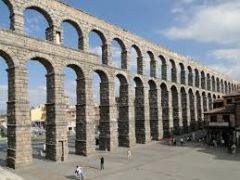
|
1. aqueduct of Segovia 2. n/a 3. local granite 4. Imperial Rome 5. design illustrates how Roman architecture could effect dominion, conquest of nature (water) |
|
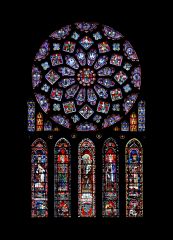
|
1. |

